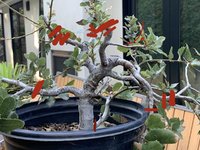ShadyStump
Imperial Masterpiece
I've searched and can't seem to find an answer, much less an example. (Which might be my answer)
I have a couple deciduous I collected in the fall that turned out to have much more trunk length below the soil line than I first realized. These are two finger thick trunks, too, and several feet long.
This leaves me 3 options if I want to keep the existing branches:
A rather straight and uninteresting literati style.
Air layering and rebuilding the roots.
A series of V notches to try adding some curve to the trunks.
I've not made up my mind yet, but in considering and researching my options, I realized that it would take multiple V notches to add the sort of curve I want. Doing them one at a time, and allowing ample healing in between would mean I could spend a decade on working a curve into a trunk of a mediocre tree.
But could I do 2 or 3 cuts at once, all bending to tree in the same direction?
Would the multiple breaks in the cambien interrupt the sap flow too much, leaving the cuts further toward the top unlikely to heal, or would a good spacing help prevent this? I know the trunk would be very compromised and subject to easier breaking for many years.
I'm still in the speculative stage, and this would mostly be prunus Americana and various elms I'm considering, so quite vigorous growers.
I'm really more curious if it's even practicable from a horticultural stand point more than actually interested in doing it any time soon.
I have a couple deciduous I collected in the fall that turned out to have much more trunk length below the soil line than I first realized. These are two finger thick trunks, too, and several feet long.
This leaves me 3 options if I want to keep the existing branches:
A rather straight and uninteresting literati style.
Air layering and rebuilding the roots.
A series of V notches to try adding some curve to the trunks.
I've not made up my mind yet, but in considering and researching my options, I realized that it would take multiple V notches to add the sort of curve I want. Doing them one at a time, and allowing ample healing in between would mean I could spend a decade on working a curve into a trunk of a mediocre tree.
But could I do 2 or 3 cuts at once, all bending to tree in the same direction?
Would the multiple breaks in the cambien interrupt the sap flow too much, leaving the cuts further toward the top unlikely to heal, or would a good spacing help prevent this? I know the trunk would be very compromised and subject to easier breaking for many years.
I'm still in the speculative stage, and this would mostly be prunus Americana and various elms I'm considering, so quite vigorous growers.
I'm really more curious if it's even practicable from a horticultural stand point more than actually interested in doing it any time soon.













